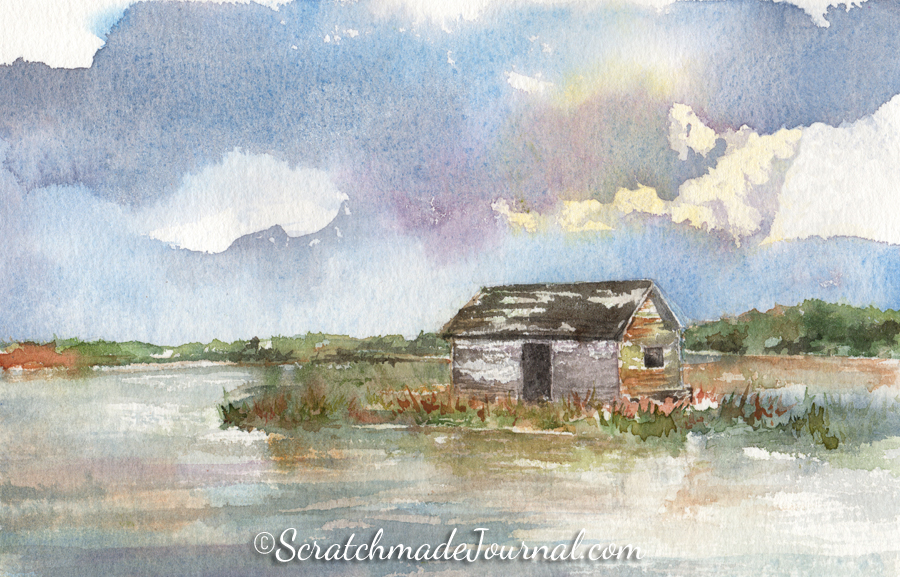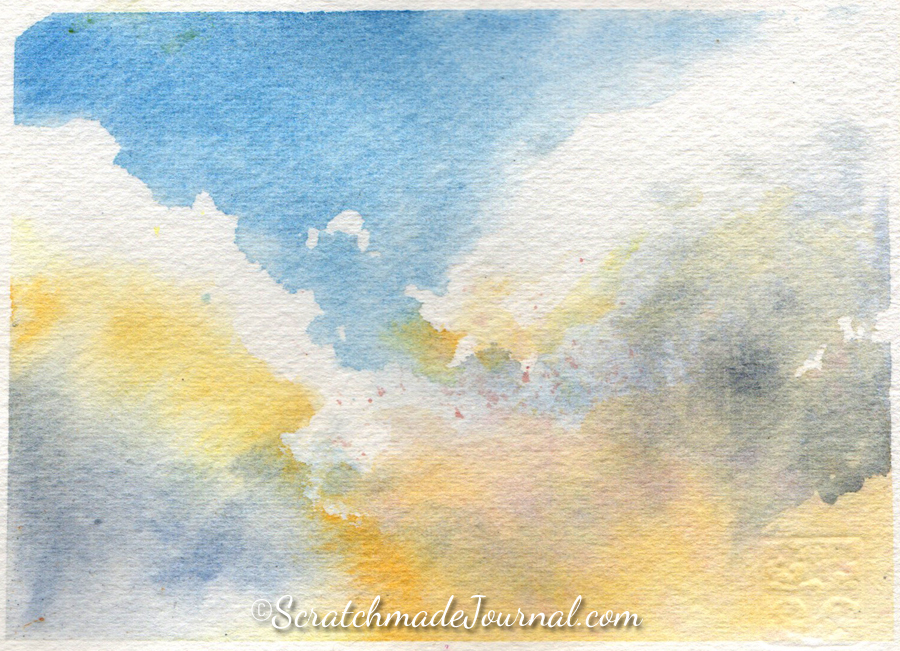Night Sky Watercolor Painting Easy
Watercolor Tutorial: How to Paint Skies & Clouds
When I began nature journaling, one of the first things I studied and attempted to sketch and paint was the sky. While I don't claim to be a master, skies and clouds are still one of my favorite things to paint and provide an ever-changing scene of inspiration.
I've already written several posts on this subject, but I thought it was time for a more in-depth tutorial on how to paint skies and clouds with watercolor. Below, I share tips for painting skies and clouds, recommended sky colors, and a video tutorial where I demo two different skyscapes with watercolor.
[Article contains affiliate links; much thanks!]
5 Top Tips for Painting Skies & Clouds

The best way to learn how to paint skies and clouds is to look up. Before beginning, spend as much time as you can observing the sky. Take reference photos, make notes, and sketch cloud formations. When you're finally ready to put brush to paper, follow these tips for success.
1) Paint the sky first. It's one of the easiest things to paint but also the most volatile so if you mess it up, you don't have a lot invested in a painting. Plus, the skyline always flows behind any landscape elements so painting the sky first allows successful layering.
2) Paint confidently and quickly, and then back away. The longer you try to paint a sky, the greater the chance you have of mucking it up. Let watercolor flow and move where it will; just be there to guide it with a gentle hand. And like a real sky, a painted sky will always look its best when situated over land and viewed from a distance. Evaluate your work at arm's length, at least.
3) Break it up, but not too much. Unless you're going for a really dramatic effect, a solid layer of blue across the sky will probably look a bit like a kindergarten painting. But don't break up the blue too much. Clouds rarely look like individual cotton balls floating in the sky. A layered, multi-colored approach will usually appear most natural.
4) Let the sky lead the composition. To create drama and interest in a painting, it often helps to use the flow of the sky, clouds, and or sunlight to move the eye towards the focal point. A large or interesting skyscape will become a key element in the composition, so plan your attack accordingly.
5) Let go of perfection. It's hard (if not impossible) to match the exact color and cloud of every single sky that you see. Instead, simply try to capture the essence or mood of a sky and its conditions and use those conditions to make the skyscape work to the painting's advantage.
Recommended Colors for Skies & Clouds
When painting skies and clouds, I wouldn't be too particular about which colors you use because nearly any colors in a palette will work. I've previously posted more information about painting the sky and choosing sky blues (see below) but I'll happily share some of my personal favorites.

Sky Blues
My everyday favorite sky blues are Cerulean (PB35/36) and Cobalt (PB28), but a lot of what works depends on location and atmospheric conditions. Ultramarine (PB29) is great for cloud shadows or humid conditions. Indanthrene (PB60; pictured above) is excellent for ominous or dusky skies and for deep shadows.
Since the sky gains warmth as it meets the horizon line, a warm blue like Manganese (PB33) or Phthalo (PB15) can also work well. Plus, warmer blues are perfect for tropical and coastal locations. I love blues so much (I have four in my palette) that it's really hard to choose a favorite, but see the articles below for more on various blues.
Learn More About Blues
• Best Blues & Tips for Painting the Sky
• Cobalt vs Ultramarine
• Cerulean Blue Watercolors
• Indanthrone Blue Watercolors
• Comparing Phthalo Blues

Sky Yellows
Only one yellow is really needed. I prefer a warm or neutral yellow like Arylide/Hansa (PY74 or PY97) or Benzi (PY154). However, an earth yellow like Raw Sienna (PBr7), Yellow Ochre (PY42), or Yellow Iron Oxide (PY43) is fantastic for adding warmth to clouds and skies.
Learn More About Yellows
• Comparing Earth Tone Yellows
• Yellow Ochre Watercolors


Sky Reds & Oranges
Adding a touch of yellow to either of the cool reds above will create a hot fiery orange that's perfect for blazing sunrises and sunsets, but feel free to take a shortcut. Transparent Red Oxide (PR101), Raw or Burnt Sienna (PBr7), Cadmium Red Light (PR108), Quin Burnt Orange (PO48) and other similar colors can really pop in a sky.
Learn More About Reds & Oranges
• All About Transparent Red Oxide
• 8-Color Palette with Cadmium Red Light

Sky Grays
My go-to sky gray and cloud shadow color is Raw Umber (PBr7) mixed with Ultramarine. (The only two colors used in the stormy sky above.) I can obtain a massive range of deep blues, grays, and blacks using only these two colors, but you could also use Raw Sienna mixed with Cobalt or Indanthrene, or try Transparent Red Oxide mixed with any of the blues.
Learn More About Grays & Blacks
• How to Mix Gray Watercolor
• How to Mix Blacks & Darks
Additional Useful Tools

Besides paper, paint, and a brush, there are only a few other tools that I use to paint clouds.
• A smooth cloth, towel or tissue is useful for lifting out clouds from the paint, and I'll demonstrate how to do this in the video.
• A spray bottle helps keep the paper damp while working and can be used to produce various atmospheric effects.
• A toothbrush can be used to splatter a fine mist like when depicting rain, and I also use it to add in additional color when a brush might mar the surface.
• Some artists like to mask in the shape of the clouds. Instead, I prefer to only place water where I want the pigment to flow and then work quickly. This reduces hard edges and produces a softer effect, but masking fluid can be an advantageous tool so feel free to use it if it helps you.
Video Tutorial: How to Paint Skies & Clouds
I've posted a video tutorial with more information along with two demos on how to paint skies and clouds with watercolor. I've also shared other resources that you may find helpful and I've listed these at the end of this post. You may also visit my channel here.
Supplies used:
• Hahnemühle Cézanne matt (cold-pressed) paper
• Legend Kolinsky Sable size 10 round
• Princeton Elite size 8 round
• Demo 1 sky colors: Cerulean Blue Genuine, Cobalt Blue, Ultramarine Green Shade, Raw Umber
• Demo 2 sky colors: Bumblebee Yellow, Red Rose Deep, Indanthrene Blue
• Demo 2 land colors: Green Gold, Hooker's Green Light, Transparent Oxide Red, Raw Umber
• Koh-I-Noor Magnum Pencil (HB)
• A spray bottle, soft toothbrush, and a damp paper towel
Paint the Sky Giveaway! [CLOSED]

Let's paint the skies together! I've got a great giveaway that's filled with wonderful watercolor supplies, and I hope you'll use this tutorial (and maybe even these art supplies!) to create your own beautiful skyscape.
The giveaway includes a landscape Kilimanjaro Watercolor Paintbook, a 24-color sample set of American Journey watercolors (full review here), a large American Journey Nomad palette with 10 full pans to fill with your favorite colors, my limited edition pouch, an SJ sticker, and more!
This giveaway has ended but be sure to follow me on social media to stay in touch & receive first notice of future giveaways and freebies!

Night Sky Watercolor Painting Easy
Source: https://www.scratchmadejournal.com/blog/watercolor-tutorial-how-to-paint-skies-clouds
Posted by: cammackreamost.blogspot.com

0 Response to "Night Sky Watercolor Painting Easy"
Post a Comment